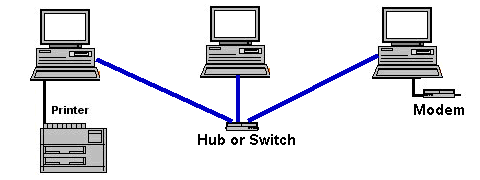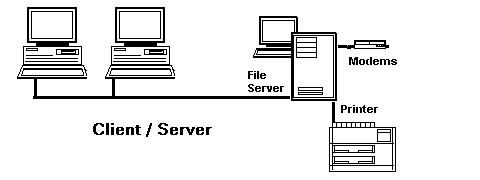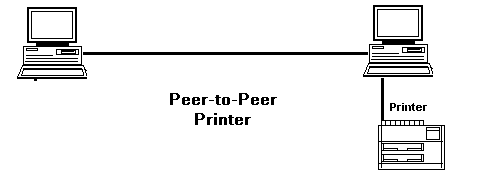Peer to Peer vs. Client Server Networks
Network require special software to control
the flow of information between users. A Network Operating System,
or NOS, is installed onto each
PC that requires network access. The NOS is like a traffic cop
that monitors the exchange and flow of files, electronic mail,
and other network information.
Network Operating Systems are classified
according to whether they are peer-to-peer
or client-server NOSs. Peer-to-peer
NOSs like Windows 95, Windows98 and Windows for Workgroups are
best for home & small office use... they are great
for sharing applications, data, printers, and other localized
resources across a few PCs. Client-server NOSs like Windows
NT, Linux and NetWare are ideal for large-scale organizations
that require fast network access for video, publishing, multimedia,
spreadsheet, database, and accounting operations.

A peer-to-peer network allows two or more
PCs to pool their resources together. Individual resources like
disk drives, CD-ROM drives, and even printers are transformed
into shared, collective resources that are accessible from every
PC.
Unlike client-server networks, where network
information is stored on a centralized file server PC and made
available to tens, hundreds, or thousands client PCs, the information
stored across peer-to-peer networks is uniquely decentralized.
Because peer-to-peer PCs have their own hard disk drives that
are accessible by all computers, each PC acts as both a client
(information requestor) and a server (information provider).
In the diagram below, three peer-to-peer workstations are shown.
Although not capable of handling the same amount of information
flow that a client-server network might, all three computers
can communicate directly with each other and share one another's
resources.
A peer-to-peer network can be built with
either 10BaseT cabling and a hub or with a thin coax backbone.
10BaseT is best for small workgroups of 16 or fewer users that
do not span long distances, or for workgroups that have one
or more portable computers that may be disconnected from the
network from time to time.
After the networking hardware has been
installed, a peer-to-peer network software package must be installed
onto all of the PCs. Such a package allows information to be
transferred back and forth between the PCs, hard disks, and
other devices when users request it. Popular peer-to-peer NOS
software includes Windows98, Windows 95, Windows for Workgroups,
Artisoft LANtastic, and NetWare Lite.
Most NOSs allow each peer-to-peer user
to determine which resources will be available for use by other
users. Specific hard & floppy disk drives, directories
or files, printers, and other resources can be attached or detached
from the network via software. When one user's disk has been
configured so that it is "sharable", it will usually appear
as a new drive to the other users. In other words, if user A
has an A and C drive on his computer, and user B configures
his entire C drive as sharable, user A will suddenly have an
A, C, and D drive (user A's D drive is actually user B's C drive).
Directories work in a similar fashion. If user A has an A &
C drive, and user B configures his "C:\WINDOWS" and "C:\DOS"
directories as sharable, user A may suddenly have an A, C, D,
and E drive (user A's D is user B's C:\WINDOWS, and E is user
B's C:\DOS). I hope you got all of that?
Because drives can be easily shared between
peer-to-peer PCs, applications only need to be installed on
one computer... not two or three. If users have
one copy of Microsoft Word, for example, it can be installed
on user A's computer... and still used by user B.
The advantages of peer-to-peer over client-server
NOSs include:
- No need for a network
administrator
- Network is fast/inexpensive
to setup & maintain
- Each PC can make backup
copies of its data to other PCs for security.
- Easiest type of network
to build, peer-to-peer is perfect for both home and office
use.

In a client-server environment like Windows
NT or Novell NetWare, files are stored on a centralized, high
speed file server PC that is made available to client PCs. Network
access speeds are usually faster than those found on peer-to-peer
networks, which is reasonable given the vast numbers of clients
that this architecture can support. Nearly all network
services like printing and electronic mail are routed through
the file server, which allows networking tasks to be tracked.
Inefficient network segments can be reworked to make them faster,
and users' activities can be closely monitored. Public
data and applications are stored on the file server, where they
are run from client PCs' locations, which makes upgrading software
a simple task--network administrators can simply upgrade the
applications stored on the file server, rather than having to
physically upgrade each client PC.
In the client-server diagram above, the
client PCs are shown to be separate and subordinate to the file
server. The clients' primary applications and files are
stored in a common location. File servers are often set up so
that each user on the network has access to his or her "own"
directory, along with a range of "public" directories
where applications are stored. If the two clients above
want to communicate with each other, they must go through the
file server to do it. A message from one client to another is
first sent to the file server, where it is then routed to its
destination. With tens or hundreds of client PCs, a file
server is the only way to manage the often complex and simultaneous
operations that large networks require.
In client-server networks, network printing
is normally handled by a print server, a small box with at least
two connectors: one for a printer, and another that attaches
directly to the network cabling. Some print servers have more
than two ports... they may, for example, support 2, 3,
or 4 printers simultaneously. When a user sends a print job,
it travels over the network cabling to the file server where
it is stored. When the print server senses that the job is waiting,
it moves it from the file server to its attached printer. When
the job is finished, the print server returns a result message
to the file server, indicating that the process is complete.
In the diagram below, the client PC sends
a job to the file server. The file server, in turn, forwards
the job to the print server, which sends it to the printer when
it's available. Any client on the network can access the printer
in this fashion, and it's quite fast. The print server can be
placed anywhere on the network, and a network can have more
than one print server... possibly one in an office's accounting
department, another in marketing, and so on.

Print Servers are available for both client-server
and peer-to-peer networks. They're incredibly convenient because
they let you put a printer anywhere along your network even
if there isn't a computer nearby. However, users often
opt not to use a print-server with their peer-to-peer network.
Why? Because every computer's resources are available to everyone
on the network, A can print a job on B's printer... just
as if A had a printer attached to her computer. In this example,
the printer is attached to the computer on the right. When the
PC on the left sends a job, it "thinks" that it is printing
to a printer of its own. In actuality, the job travels
over the network cables to the PC on the right, which stores
and prints the job in the background. The user at the PC with
the printer is never interrupted while his computer processes
and prints the job transparently.

|
Remote Access & Modem Sharing |
When a client-server network needs a gateway
to the world, the network administrator usually installs a remote-node
server, which serves up two functions: remote access and modem
sharing. Most remote-node servers attach directly to the network
cabling; they provide a bridge between the network, a modem,
and a telephone line.

Remote access allows users to dial into
their home networks from anywhere in the world. Once a
connection has been established over ordinary phone lines by
modem, users can access any programs or data on the network
just as if they were seated at one of its local workstations.
Some remote access servers only provide access to a file server's
disk drives. Others can provide access to both the file server
and direct access to any PC's hard disk on the network. This
saves time because it allows a remote user to communicate directly
with any network user without having to go through the file
server.
Modem sharing lets local network users
dial out from their individual network computers to access the
Internet. After firing up their favorite communications
software, local users establish a link with the remote-node
server over the network, which opens up an outgoing telephone
line. Users' individual PCs don't need modems, which is
a big money saver... only a single modem & phone line
are required for tens or hundreds of users. In the case of peer-to-peer
networks, by contrast, every PC requires its own modem for access
to the outside world, unless you use special software packages
like Wingate or
Sygate that can provide
the same ability to a Peer-to-Peer network.